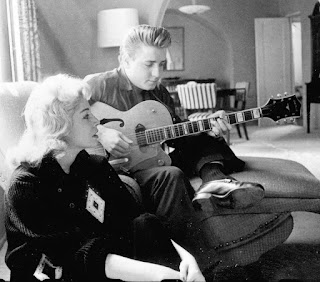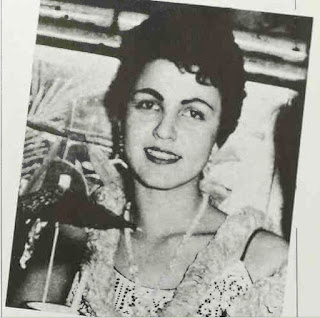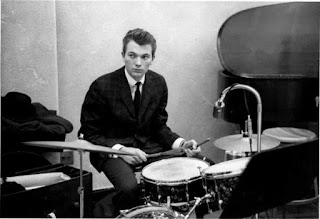One reason that J. D. Salinger’s writing can seem juvenile is that it contains no adult sexuality, which is not the case with Mailer, Kerouac, and Burroughs. The Teenage Impersonator impersonated only boys. Salinger is Holden Caulfield, but Salinger is not Esmé. “What do you think about Esmé?” Salinger asked. “She’s right on the edge between the innocent wise child and the woman,” Peter Tewksbury said. “And the whole story rests on that moment... a minor chord that builds up to that peak moment before it becomes a major.”
Salinger agreed to allow Tewksbury to make his film on one condition: Salinger would cast Esmé. In March, Congress convened hearings as part of its investigation into the ratings industry. Tewksbury was the first person to testify. Tewksbury charged that ratings could be bought. Salinger admired Tewksbury, and not just for “It’s a Man’s World.” Toward the end of the nineteen-sixties, Tewksbury threw his Emmy out the window of a car and left Hollywood. Source: www.newyorker.com
It probably takes an eccentric to really do Howard Hughes justice, so the enigmatic Warren Beatty is well-suited to the film. Although he’s playing Hughes at a point when he was still in his fifties, Beatty, although often shrouded in darkness or seemingly wearing make-up to soften his features, looks remarkably good for his age and isn’t hard to believe in the role. Poking fun at his own ladies-man image, here Hughes is almost buffoonish with ladies, not that it matters much with his money. Largely playing the role for laughs, Beatty is funny in the role and seems to be having a ball, especially when imitating Hughes’s wayward way of making a point, while occasionally giving us a peek at the very real mental issues the mogul was facing. Source: www.joblo.com
Men who see themselves as playboys or as having power over women are more likely to have psychological problems than men who conform less to traditionally masculine norms, according to research published by the American Psychological Association. “In general, individuals who conformed strongly to masculine norms tended to have poorer mental health and less favorable attitudes toward seeking psychological help, although the results differed depending on specific types of masculine norms,” said lead author Y. Joel Wong, PhD, of Indiana University Bloomington. The study was published in the Journal of Counseling Psychology®. Source: www.apa.org
The Howard Hughes of Rock and Roll: Phil Spector. When, in the mid-1960s, the British Invasion eclipsed him, Spector's fragile self-esteem was shattered. When he tried LSD, he glimpsed his father's suicide. Freaked by the Manson family murders, he withdrew behind electric fences, guard dogs, bodyguards and guns. His career-rescuing collaborations with John Lennon, likewise deserted by his father at a young age, concluded with Spector firing his revolver into the studio ceiling. Increasingly crushed by the weight of his own achievements, he took to the bottle and gradually faded.
Poleaxed by Lennon's murder in 1980, Spector disappeared altogether with a third wife, Rachelle Short, his erstwhile PA. When Mick Brown interviewed Phil Spector for The Telegraph, he seemed consumed by his self-image as Rock's Howard Hughes. Source: www.telegraph.co.uk
John Lennon himself withdrew for many years, then tried peeking out again, with the tragic results we know. These questions come to mind in reading David Shields and Shane Salerno’s biography “Salinger” (2013) because, in one of the most bizarre sections of a bizarre book, they themselves raise the issue of murder-by-bad-reading, in connection with the murder of the Beatles’ John Lennon by Mark Chapman, who happened to have hallucinated a motive within “The Catcher in the Rye.” Shields and Salerno insist that Chapman was not just a crazy hallucinant, but in his own misguided way an insightful reader, responding to the “huge amount of psychic violence in the book.” Now, there is a section in “Catcher” in which Holden fantasizes about shooting, but it is exactly a bit of extended irony about the movies' effect on everyone’s imagination. In Salerno’s “acclaimed documentary film” a witness points out that the word “kills” occurs with ominous regularity in the text—failing to acknowledge that this is Holden’s slang for the best things. “She kills me” is what Holden says about his beloved little sister Phoebe.
A simple theory is flogged: that Salinger was a victim of P.T.S.D., screwed up by a brutal combat experience in the Second World War. It’s a truth that Salinger himself dramatized at beautiful length in his story “For Esmé—with Love And Squalor,” and then left behind. Holden is far too young to be a veteran, and Seymour Glass was in the armed forces, like most of his generation, but never in combat: the proximate cause of his suicide is a bad marriage.
In any case, Salinger’s work emphatically editorializes its moral point, which is about as far from sublimating violence as any writing can be: Phoebe, the Fat Lady, Esmé, innocence, and small domestic epiphanies are good. Violence, the military, cruelty are all bad. That Salinger was wounded by combat is obvious; Holden’s sweetness and essential helplessness was shared by hundreds of artists of the period (most of whom had never held a rifle). The two writers who meant the most to Salinger, Ring Lardner and F. Scott Fitzgerald, seem left largely out of the book’s discussion. Source: www.newyorker.com
Danger and death became essential ingredients of the rock generation's ethos, infusing young people with a sense of tragedy. The materialistic world of the fifties seemed to snuff out the sensitive, like poet Sylvia Plath, or drive them to nervous breakdowns, like Seymour Glass and Holden Caulfield. Rock and roll was banned on the BBC, but John Lennon listened to it on the privately owned Radio Luxemburg. The Los Angeles Buddy Holly discovered in 1957 was at its height as a supermarket of cockeyed metaphysical urges; a neon sign on La Brea advertised "Car Wash and Mind Control." There were Mildred Pierce-type restaurants with numbered booths and nice apartments on Holloway Drive that could be rented for $227 a month. On the road, Buddy Holly concealed his .22 in his shaving kit. He had acquired his gun when he started collecting the Crickets' performance fees directly from the promoters. The Big Bopper once said that you must always get a 'first count'. –"Buddy Holly: A Biography" (2014)
-Ear Candy Mag: In the book THE DAY THE MUSIC DIED, it was mentioned that the Big Bopper just wanted to stay in the singing business long enough to get money to buy his own radio station…
-Jay Perry Richardson: That's what dad wanted to do, mom says he wanted to buy a station in Denver to start with. For some reason he wanted to move to Denver. And the performing side of it, dad was really a shy kind of guy. When he put on that jacket or got behind a microphone, he was a character. People say, "Boy, your dad must have been a crazy guy". And, he really wasn't. I mean my dad. Now the Big Bopper, yeah he was a nut. That was part of the act.
The Big Bopper was a 'character'. That was not my dad, distinguish the two. My dad was a laid back, intellectual thinking kind of guy trying to move forward in the music business and had all these ideas and knew where he wanted to go. The 'Bopper' was the thing that he created for his radio show. And they just took it into his music. Just so happened the first song that he recorded - "Chantilly Lace" was the flip side of "The Purple People Eater Meets the Witch Doctor". It just so happens that it took off. I believe that my dad just would not believe the way people react to his music today... he was just trying to make a living to support his family. Source: www.earcandy.com
-Jay Perry Richardson: That's what dad wanted to do, mom says he wanted to buy a station in Denver to start with. For some reason he wanted to move to Denver. And the performing side of it, dad was really a shy kind of guy. When he put on that jacket or got behind a microphone, he was a character. People say, "Boy, your dad must have been a crazy guy". And, he really wasn't. I mean my dad. Now the Big Bopper, yeah he was a nut. That was part of the act.
The Big Bopper was a 'character'. That was not my dad, distinguish the two. My dad was a laid back, intellectual thinking kind of guy trying to move forward in the music business and had all these ideas and knew where he wanted to go. The 'Bopper' was the thing that he created for his radio show. And they just took it into his music. Just so happened the first song that he recorded - "Chantilly Lace" was the flip side of "The Purple People Eater Meets the Witch Doctor". It just so happens that it took off. I believe that my dad just would not believe the way people react to his music today... he was just trying to make a living to support his family. Source: www.earcandy.com


































































